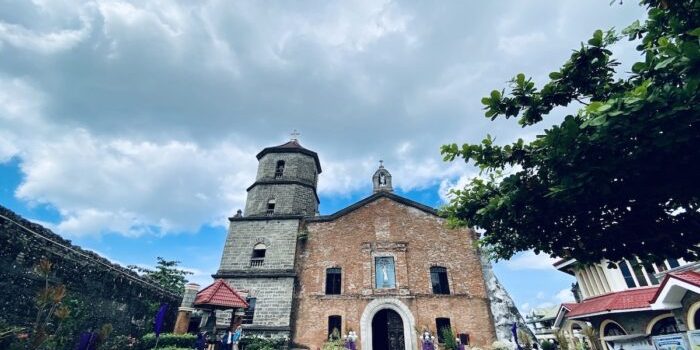Out of Town Blog
BOAC CATHEDRAL: Immaculate Conception Cathedral Parish
Boac Cathedral in Boac, Marinduque
Boac Cathedral, officially known as the Immaculate Conception Cathedral Parish, is a historic Roman Catholic church and cathedral located in the town center of Boac, Marinduque in the Mimaropa region of the Philippines. This fortress-like cathedral, built in 1792, is an exquisite example of Hispanic Gothic architecture adorned with intricate carvings and a bell tower inspired by Paoay Church in Ilocos.
Cathedral in Boac Marinduque
Regarded as the greatest monument of faith and history in the area, Boac Cathedral serves not only as a place of worship but also as an important cultural property of the National Museum. Throughout its storied past, it has provided refuge to the people of Marinduque during calamities and wars.
A visit to Boac Cathedral allows tourists and locals alike to experience a piece of Marinduque’s heritage. The captivating building, coupled with the surrounding town, makes this cathedral a must-see destination when exploring the Philippines.
Spanish Era and Foundation
The Boac Cathedral, officially known as the Immaculate Conception Cathedral Parish, holds great significance in the history of Marinduque. Built in 1792, this baroque church has stood the test of time and has become a symbol of religiosity on the island. The cathedral was established as part of the Spanish era’s spiritual administration when Fray Alonzo Banol, a Franciscan missionary, planted the first cross on Marinduque island in 1579. Located in Barangay Mataas na Bayan, Boac Cathedral served as a cornerstone for the expansion of Christianity in the region.
Boac Church Historical Marker
Defense Against Pirate Attacks
Throughout the years, Boac Cathedral has not only been a place of worship and spiritual refuge but also acted as a fortress against external threats. During the 1800s, it provided shelter and protection to the locals against pirate attacks. Constructed primarily out of adobe, the cathedral’s robust structure and bell tower served as effective defensive measures.
In addition to its defensive role, Boac Cathedral played a significant part in the Philippine Revolutionary War. In 1899, the Philippine Revolutionary flag was blessed within its walls, making it a crucial landmark in the nation’s fight for independence.
National Museum Declaration
In recognition of its rich historical past and cultural importance, the National Historical Institute declared Boac Cathedral an Important Cultural Property in the Philippines. The National Museum also acknowledged the cathedral as a Heritage Treasure, further emphasizing its value as a testament to the island’s heritage and history.
Visitors to Boac Cathedral can appreciate its beautifully carved doors, exterior walls made of red bricks, and the historical markers placed by the National Historical Institute. These markers draw attention to Boac Cathedral’s storied past and its unwavering importance to the people of Marinduque, as both a center of faith and a symbol of their resilient spirit.
Design and Structure
Boac Cathedral, located on Marinduque Island, features an impressive design that combines functionality with beautiful aesthetics. The cathedral’s structural elements, such as its massive buttresses and rough terra cotta, were specifically designed to withstand seismic activity. The interior of the cathedral showcases simple yet intricate carvings, reflecting its Hispanic Gothic architectural inspiration.
Some noteworthy features include:
Grand facade and bell tower made of adobe stones
Massive buttresses resembling those of Paoay Church in Ilocos
Baroque Influence
The Boac Cathedral is a prime example of Earthquake Baroque architecture, which was adapted to ensure the building’s durability during seismic events. This style incorporates elements of Baroque design into the architecture, making it both visually stunning and earthquake-resistant.
Some elements that reflect the Baroque influence include:
Ornate decorations: Featured in the cathedral’s exterior and interior, these decorations consist of sculptures, carvings, and paintings that give the building a distinctive character.
Complex shapes: The cathedral’s design incorporates a variety of geometric shapes and patterns to enhance its visual appeal and provide structural support.
Grand scale: The Boac Cathedral has a monumental presence, symbolizing its significance as a monument of faith in Marinduque’s history.
The Boac Cathedral’s unique combination of design, structure, and Baroque influence make it a significant architectural gem and a testament to the enduring faith of the people of Marinduque.
Religious Significance
Immaculate Conception Parish Church
The Boac Cathedral, officially known as the Immaculate Conception Cathedral Parish, holds great significance in the history of Boac and the province of Marinduque. It is a symbol of religiosity on the island, eliciting faith and worship from the people.
Built in 1792, this Baroque church has withstood the test of time and various natural calamities. Boac Cathedral continues to be a spiritual refuge, providing a stately space for people to come in times of need and find solace in their faith.
Our Lady of Prompt Succor
One of the defining features of Boac Cathedral is the devotion to Our Lady of Prompt Succor. The locals consider her their defender from pirate attacks in the 18th century. The church was built in honor of Our Lady of Prompt Succor, and her presence serves as a beacon of hope and strength for the community.
At the heart of the worship and religiosity in Boac Cathedral, this venerated icon has become a cornerstone of the local faith, drawing people closer to the divine through the intercession of the Blessed Mother.
Bishop Marcelino Antonio Maralit
Boac Cathedral is under the care and guardianship of its incumbent bishop, Bishop Marcelino Antonio Maralit, who is well-regarded for his spiritual leadership in Marinduque. Together with the Parochial Vicar and other clergy members, they strive to maintain the church’s pivotal role in upholding the people’s religiosity.
In this capacity, the bishop works towards fostering an environment where people feel nurtured in their faith journey and encouraged to grow in their relationship with God. This guidance and direction from the church’s leaders has helped strengthen the bond between the community and Boac Cathedral, solidifying its role as a center of worship and spiritual refuge.
Cultural Importance
Moriones Tradition
The Boac Cathedral holds a significant place in the hearts of Marinduqueños due to its connection with the Moriones tradition. This centuries-old tradition is celebrated each Holy Week in Marinduque, and is known for its bright and colorful costumes depicting Roman soldiers. The cathedral serves as an important venue for the Moriones Festival, where devotees gather during the Lenten season to reenact the story of Saint Longinus, whose miraculous conversion was attributed to witnessing the crucifixion of Jesus Christ. The Boac Cathedral is considered a symbol of religiosity, faith, and history for the Marinduqueños, making it an essential destination during the Moriones celebrations.
Heritage and Preservation
In 2018, the National Museum declared the Boac Cathedral an Important Cultural Property. This recognition has ensured that the cathedral is protected and preserved for future generations. With a history spanning four centuries, the Boac Cathedral is a treasure trove of architectural, cultural, and spiritual significance.
Its architectural design exhibits Earthquake Baroque style, characterized by thick walls, buttresses, and lower bell towers. These design elements not only showcase the grandiosity of the structure, but also its ability to withstand numerous calamities, such as fires and earthquakes, throughout its existence. The preservation efforts for the Boac Cathedral are aimed at maintaining the structural integrity and historical authenticity of the cathedral, ensuring that it remains a source of pride and inspiration for the Marinduqueños.
Inside Boac Church
Iconography and Art
Boac Baptismal fontBoac Cathedral Main Altar
Altar and Religious Artifacts
The Boac Cathedral features a beautiful altar that showcases its richistory and deep religiosity. Not only does it hold great cultural significance, but it also serves as a symbol of faith for the people of Marinduque. The Immaculate Conception Cathedral Parish was built in 1792 and has stood the test of time as a prominent landmark on the island.
The church’s interior is adorned with a wide array of religious artifacts that are essential in representing the iconography and art within the cathedral. Some of these artifacts include:
Exquisite carvings of religious figures
Highly detailed murals on the walls and ceilings
Elegant stained glass windows depicting biblical scenes
These art pieces and artifacts not only serve as reminders of the church’s spiritual purpose, but they also provide insight into the craftsmanship and artistic talents of the people who created them.
Bell Tower and Bells
The Boac Cathedral also features a prominent bell tower, which is an essential part of its religious and historical significance. The bell tower has a fascinating history, as it was designed as a fortress against pirate attacks in the 18th century. This strategic location at the highest point of the town allowed it to protect and defend the local population.
The bells housed within the tower have been carefully preserved, providing a window into the rich history of the cathedral. These bells, some of which date back to the 1700s, were used not only for religious purposes but also as an early means of communication with the surrounding community. These bells are still in use today, sounding out across the town to signal mass and other important events.
Boac Cathedral in Marinduque
Frequently Asked Questions
What is the architectural style of Boac Cathedral?
The architectural style of Boac Cathedral is a mix of Spanish-era structures, characterized by its red-brick exterior walls and beautifully carved doors. Its fortress-like appearance sets it apart from other churches in the Philippines.
What role does Boac Cathedral play in the community’s cultural activities?
Boac Cathedral serves as a vital part of the Marinduqueños’ colorful history and culture, symbolizing their deep religiosity. The cathedral has been a primary venue for religious and cultural events in the community.
How has the history of Boac Cathedral influenced tourism in the area?
The more than 200-year-old Boac Cathedral attracts tourists with its historical significance and unique fortress-like architecture. Its presence in Marinduque has made the island a more appealing destination for travelers interested in historical and cultural sites.
In which century was Boac Cathedral constructed?
Boac Cathedral’s construction began in 1792, making it a product of the 18th century.
Are there any notable artworks or relics housed within Boac Cathedral?
Upon entering Boac Cathedral, visitors will notice numerous beautiful carvings on the doors and exterior walls. While specific details on noteworthy artifacts are limited, the church’s interior adds more charm and allure to visitors seeking a deeper understanding of its history and artistic elements.
Follow and Subscribe to OutofTownBlog.com on Facebook, Twitter, Instagram, Pinterest, and YouTube for more Marinduque tourist spots.
Read:
MARINDUQUE TRAVEL GUIDE: Itinerary + Things to do, How to get There and more
SAN AGUSTIN CHURCH, MANILA: A UNESCO World Heritage Site
Butterflies Are Icons In Marinduque And Here’s Why
BOAC CATHEDRAL: Immaculate Conception Cathedral Parish
Team Out of Town
Out of Town Blog







